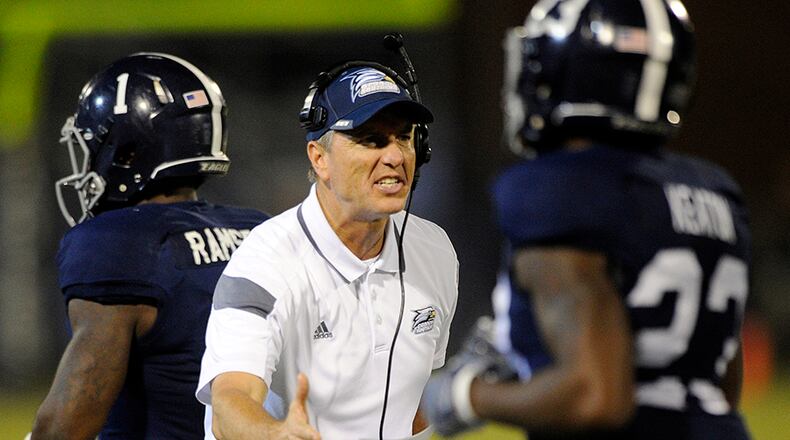GEORGIA SOUTHERN FOOTBALL TIMELINE
April 9, 1981: Georgia Southern President Dale Lick announces plans to restart the football program that was discontinued at the start of World War II.
May 23, 1981: Former Georgia Bulldogs defensive coordinator Erk Russell named Eagles coach.
Sept. 29, 1984: After competing for two seasons as a club team, the Eagles defeat Liberty 48-11 in the first game in Paulson Stadium.
Dec. 21, 1985: In just second season in Division I-AA, Georgia Southern wins first national title. The Eagles beat Furman 44-42, as quarterback Tracy Ham throws for 419 yards, including a game-winning 13-yard touchdown pass with 10 seconds remaining.
Dec. 16, 1989: Erk Russell wins final game as Eagles coach, defeating Stephen F. Austin 37-34 for his and Georgia Southern's third Division I-AA title.
Dec. 4, 1999: Running back Adrian Peterson rushes for school-record 333 yards in playoff victory over UMass. Peterson then leads team to another national championship.
Dec. 16, 2000: Paul Johnson coaches the Eagles to the team's sixth and final Division I-AA championship.
Sept. 8, 2006: Erk Russell dies, shortly after mending ties with Georgia Southern. He had split from the school after his son was fired from coaching staff in 2004.
March 27, 2013: Georgia Southern announces it will move up to FBS competition, leaving the Southern Conference for the Sun Belt. It will be eligible for Sun Belt conference title in 2014, but not eligible for a bowl until the 2015 season.
June 12, 2013: Construction begins on new deck at Paulson Stadium, increasing capacity to 25,000. The school also adds a $10 million, 50,000-square-foot office/team complex.
April 26, 2013: Safety J.J. Wilcox drafted in the third round, 80th overall pick, the highest a Georgia Southern player has been taken.
Nov. 23, 2013: Georgia Southern beats Florida 26-20 in the Swamp.
Sept. 20, 2014: Georgia Southern wins at South Alabama 28-6 in Sun Belt Conference opener.
On the day in 1981 that Erk Russell was introduced as the first head coach of the reborn Georgia Southern football program, the school didn’t own so much as a ball to use as a news conference prop.
Russell, the bald-headed Southern Aesop who loved to spin fables, used to tell the story of how administrators had to run to the Statesboro K-Mart to buy one for the big announcement. That just sounded a little more blue collar than the truth. In fact, it was a local sporting goods store owner who contributed the first ball.
So committed was Russell to maintaining the legend that, “They even had a football in the team offices with K-Mart on it,” Frank Hook said. Hook knows the real story because he was the store owner in question. He long ago gave up selling balls and bats and moved into the Eagles’ athletic office, where he’s now the interim president of the program’s athletic foundation.
Here, 30 years after Georgia Southern played its first Division I-AA (now FCS) game, the Eagles wear their humble beginnings proudly, like a country singer wears denim.
The Eagles have plenty of footballs these days, along with a new second deck on their stadium, a shiny new team complex and a new place in the top division of the college game, the FBS.
Patience pays off in new adventure
Entering this season, their first to be eligible to compete for a Sun Belt Conference title, the Eagles were picked to finish eighth in a coaches’ poll. Instead, at 4-0 in the conference, they lead the thing. They are a one-point loss to N.C. State and a four-point loss to Georgia Tech away from being unbeaten. They must serve out this one more season in the FBS transition before becoming bowl eligible.
Their first-year coach, Willie Fritz, invokes the image of a Boise State when describing Georgia Southern ambitions. The goal is the same: To turn a lesser-known, lesser-funded program into a rankings interloper, one that throws more scares into the big guys than an NCAA compliance officer.
The school president refers to the new stadium addition as a “mid-deck,” as if to hold out the vision that another could be added atop it.
Georgia Southern will be traveling I-16 this week for a first meeting Saturday with Georgia State. Both are newbies to the Sun Belt. And, yes, both are members of the University System of Georgia. Beyond that, they have little else in common.
The urban school went all fast track, going from zero to FBS in just four seasons.
The country folk were more patient, opting to make a bigger splash in a smaller pond, laying down layers of tradition and learning to win along the way (six Division I-AA national titles).
“Well, you know farming is a big part of our community, and we like to plant our crops and wait for them to grow,” chuckled Tracy Ham, the quarterback who helped start it all, winning championships in 1985 and ’86.
“In the big city, it’s the bright lights, its different. I’m not saying that’s wrong, it’s just that our way worked pretty good for us,” said Ham, an associate athletic director for special projects at his old school.
Maybe one day Georgia State will tell colorful tales of its own up-from-nothing struggle, but its upcoming opponent has a nearly three-decade head start on the lore building. Where Georgia Southern finds itself now — making the jump to FBS look almost easy, while Georgia State, as of this weekend, had yet to beat a Sun Belt opponent — is all the more impressive when considering where the Eagles were 30 years ago.
Risk leads to rewards
There was some resistance to the move to FBS, questions from a cautious community wondering whether the school could compete both financially and on the field. The students voted with their — or their parents’ — wallet, agreeing to a $100-a-semester activity fee to help pay for the step up.
But, then, boosters were accustomed to push-back. Back in the early 1980s when then-university president Dale Lick had the idea to restart football after a 40-year absence, he heard all the warnings.
“I had the (state) chancellor tell me that there were two things that could kill a university: Putting in a medical school and starting football,” recalled Lick, who was Georgia Southern’s president from 1978-86.
Lick was convinced that football was an essential tool in building the brand of a small-town college that found itself perpetually fighting for students and funding. The enrollment was 6,200 when he arrived, and it’s more than 20,000 now. He noted that applications from top-tier students tripled after the Eagles won their first national championship.
Those early days were a study in football on a shoestring — and the shoestring often was on loan from someone else.
The first two years Georgia Southern treated football as a club sport before the stadium, built with a million-dollar assist from Gulfstream jet tycoon Allen Paulson, was ready for the real thing in 1984.
The original coaches’ office was a double-wide. When students tried out for the first team, they ran their sprints on a tennis court.
To this day, the Georgia Southern uniforms are among the plainest in the land, a traditional answer to the Oregon-ization of football fashion. That is a direct throwback to the days when the Eagles had no choice but to wear their most presentable practice jerseys on game day. (Even they have an alternative look these days).
Bucky Wagner, the athletic director during football’s reawakening, tells the tale of driving a van around to places like Florida State and Alabama and loading up on their spare equipment.
“We once had a person in Nashville donate about four dozen shoulder pads, and they were all XXL. In 1982, we didn’t have anyone big enough to fit into them. We had to try to trade them out for smaller ones,” said Wagner, now retired.
“My pads didn’t always smell brand new when I got them,” Ham said. “But our equipment guy always made it seem we were getting the very best equipment.”
For transport from their remote dressing quarters to the stadium, Wagner bought a couple of old school buses from the county for $250 each. Those yellow hulks still run, and while the locker room is easily within walking distance of the field, the players still take a ride in them before the game through the tailgate area.
Larger-than-life coach
The hiring of Russell was the ultimate master stroke. Here was the most charismatic coach off the Georgia staff, the long-time defensive coordinator whose signature was head-butting his helmeted players until his forehead bled.
“Think about it nowadays: A start-up program hiring the defensive coordinator from a school coming off a national championship (1980). That doesn’t happen. You couldn’t pay the guy enough to do it. And the guy wouldn’t take the job,” today’s coach, Fritz, said.
“Once the Erk Russell news came out, we had instant credibility,” Ric Mandes, who handled the marketing all those years ago, said.
In love with the idea of starting a program from scratch, hungry to create his own legacy, Russell went from Athens to Statesboro for a $1 raise, plus a few other perks. As well as a coach and motivator, he was the perfect carnival barker for a start-up program.
Step right up and see the prettiest little stadium in America (his term for the original Paulson)! Marvel at the magical powers of the water from beautiful Eagle Creek (drawn from a weedy ditch that bordered the practice field)!
Twenty-five years after he cradled that borrowed football and announced his arrival, Russell died in Statesboro. Hook got another phone call. The family was in need of another football to place next to the late coach for his viewing. This time Hook delivered one from the Georgia Southern athletic department.
“I took the first football to coach Russell and his last,” Hook said fondly.
Because everything happening now with Georgia Southern football was built on the foundation of its past, Russell’s presence is still felt all around the program. Earlier this year, after some visiting friends had toured the town, they asked Fritz for more information on this Erk Russell fellow they had heard so much about. They were shocked to hear that such an omnipresent figure had been dead for nearly eight years.
One can only imagine that Russell would be right pleased with what Georgia Southern is doing with its football today.
About the Author





